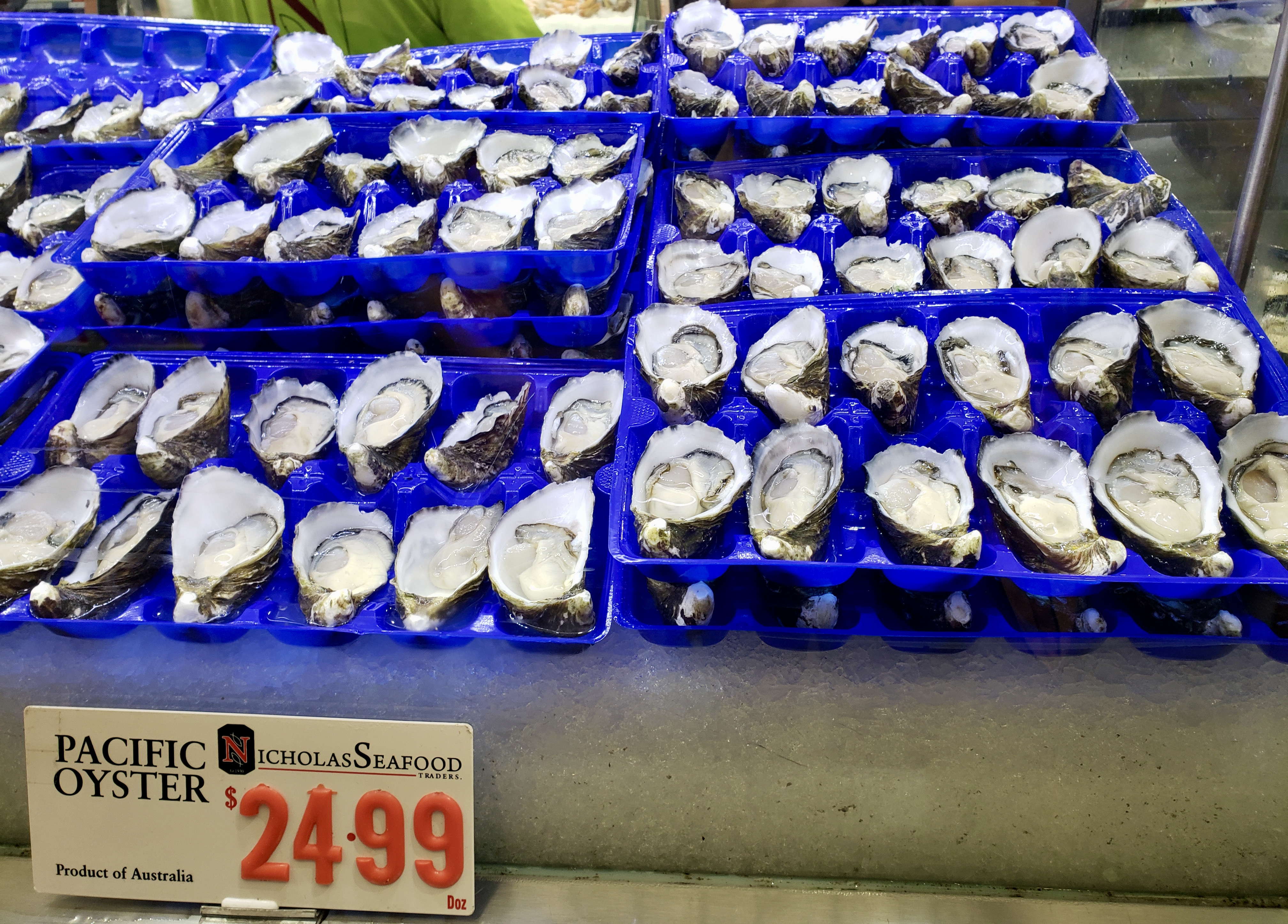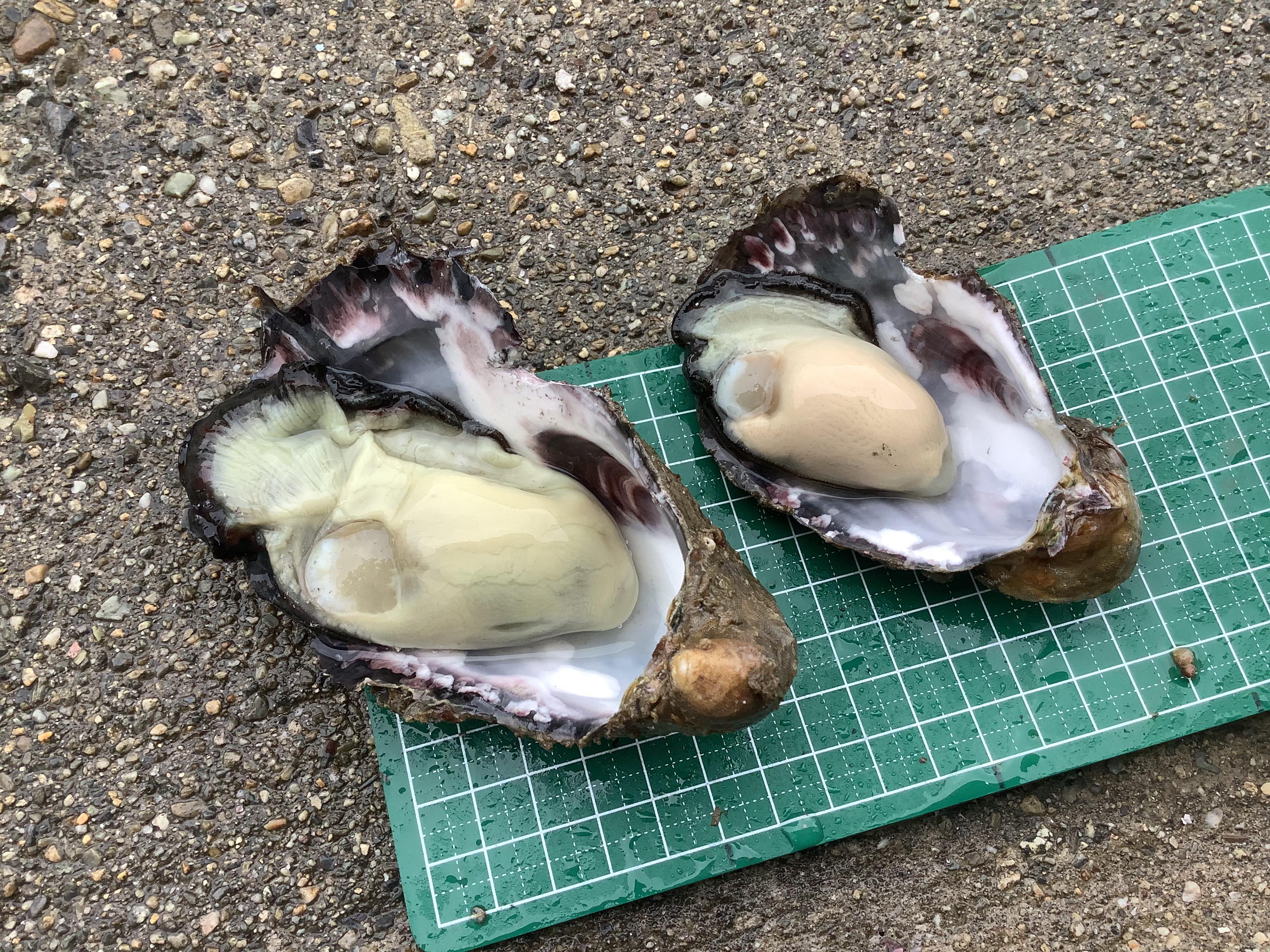Spawnless Nature in the Making
Mariko Yoshida
07/17/2024 | Projects
Oyster nature in translation
Merroir is no longer just a gustatory value tied to the aquatic and terrestrial realms; it is generated within the cells of oyster bodies. Biotechnological applications that induce infertility by creating chromosomal abnormalities, namely triploidy, alter the condition of life as “being earthbound.” Chromosome manipulation makes oysters amenable to year-round marketability and faster growth, thereby enhancing their commercial value. However, as bioindustrial efforts strive to standardize the future of genomic capital in pursuit of permanence in precarious times, both oyster nature and human labor become estranged from the conditions of species being. Scientists point out that induced triploidy might render oysters and other species more susceptible to environmental stressors. Despite their year-round availability, some local producers still suspend shipments of triploids in summer as an unprecedented combination of rising sea surface temperatures and low salinity due to heavy rains worsens meat quality. The pitfalls of technosolutionism are evident; intervening variables influencing new aquaculture practices multiply, and social angst persists.
In my work-in-progress monograph, which draws on years of multi-sited ethnographic fieldwork in Japan, Australia, and the US Pacific Northwest, I examine the modes of production, circulation, and consumption of the Pacific Oyster (Crassostrea gigas; magaki), a species endemic to East Asia that currently represents 80 percent of the world’s total production of oysters for human consumption. I explore inter- and intra-species metabolic disruptions that unfold due to political ecological contingencies associated with the control of life. In this blog post, I share some of my inquiries into the process by which oyster nature is transformed into a capitalist commodity, devoid of the capacity to spawn, to meet the dual demands of market consumption and resistance against underwater precarity. Triploidy exemplifies modes of serving as a bioengineering solution against metabolic and market instability, yet its socio-material practices lead to a relational process of multiplication of reality.

Figure 1. Triploid Pacific oysters on the half shell sold by a seafood retailer at Sydney Fish Market during summer months. Photo by author.
Reproducing the nonreproductive
The oyster industry today is impelled to extract new value from a bioengineered setting where their reproductive functions are controlled and regulated.1 Human intervention in artificially inducing an additional set of chromosomes in oysters has resulted in triploidy, where an organism has three sets of chromosomes instead of the usual two (diploidy). The bioindustrial motive for this intervention is accelerated by multiscalar underwater metabolic disruptions. Warmer water holds less dissolved oxygen, impacting the distribution of phytoplankton, which has shifted to areas where water temperatures were previously lower. As a result, the metabolic capacity of these immobile filter feeders to store glycogen is hindered. The frequency of slower growth and massive die-offs of seed oysters (spat) has increased in areas where production in the wild environment was previously stable. Oysters are osmoconformers; they adjust their internal salt levels to match their surroundings by releasing and absorbing free amino acids. However, this energy-demanding process becomes compromised by rapid changes in sea conditions, weakening oysters’ immune defenses against pathogens and parasites.
Under these circumstances, value produced in the form of bioengineered cyborgs has been optimized for capital. A shellfish firm in Washington State attempted to hybridize two oyster species – Sikamea and Gigas – as part of their selective breeding operation. However, this resulted in excessively large, slower-growing oysters, which proved less profitable for the US Pacific Northwest industry.2 Meanwhile, chromosome manipulation is designed to meet market demand for stable, year-round, and standardized supply. As hybrids of artificial and natural life forms, triploids exhibit significantly reduced production of eggs and sperm, redirecting energy towards body growth. Consequently, spawnless triploids grow faster and become meatier throughout the year compared to naturally occurring diploids.
While consumers often cannot distinguish between naturally occurring fertile diploids and artificially manipulated sterile triploids, local producers discern distinct differences, particularly in flavor. The flavor of diploids undergoes significant changes when the gonads responsible for egg and sperm release transform. In contrast, triploids maintain a relatively consistent flavor throughout the year. Artificially sterile oysters are no longer bound by the constraints of a peak season.3

Figure 2. On the left, a triploid oyster; on the right, a diploid oyster, both cultivated in the same environment using identical farming methods. Photo courtesy of Isao Kimura, May 2024.
Intraspecies alteration, technosolutionism, and unfulfilled promises
In Japan, triploidy has been applied to several bivalves and fish species since the early 1980s. As extensive triploid breeding continues to advance and yield visible returns on the government’s investment, a few private contractors and the Hiroshima Prefecture Fisheries Cooperative Association have incorporated triploidy into their aquaculture businesses. In addition to standardizing faster growth and year-round meatiness, enhancing tolerance to high water temperatures is another concern of biotechnological ventures. Notably high water temperatures have been observed in summer across the country, resulting in premature product quality on the first day of the pre-shucked oyster auction at Japan’s largest fish market, Toyosu Fish Market, held on October 1. It sparked speculation that the extended period of elevated temperatures and the weakening caused by repeated spawning were contributing factors to the die-offs. One oyster producer in Japan expressed, “Without proper methods to adjust to ocean changes, they [oysters] perish easily…we call oysters with insufficient plumpness and size ‘snotty oysters (hanatare-gaki)’ or ‘watery oysters (mizu-gaki).’ Oysters that become flabby and thin after spawning never fetch good prices when auctioned off to wholesalers.”
The ploidy manipulation technique today involves enhancing specific traits within oyster populations to even resist diseases. During my 2018 fieldwork in southern Tasmania, an Australian commercial supplier of triploid shellfish seed explained their process of identifying POMS (Pacific oyster mortality syndrome)-resistant genes. They map regions of the genome that distinguish survivors from non-survivors and breed POMS-resistant triploid oysters selected from the survivors that demonstrated immunity. These survivors then become their future broodstock, featuring improved genetics and heightened resistance to POMS.4
Yet, these practices of biotechnological intervention, aimed also at accommodating nonhuman biosecurity, are entrenched in patchy unpredictability. Triploid oysters are less able to handle extreme environmental stress, including heatwaves, because their biophysiological responses are not as robust as those of diploid oysters. This could inadvertently lead to the emergence of biotechnology-driven diseases and more virulent forms, potentially resulting in far-reaching consequences for oyster health. In an era when anthropogenic biology is widely applied at the cellular level, with reproduction being selectively managed and sterilized, the desired outcomes of in-vitro ploidy manipulation are never fully realized. Instead, these interventions give rise to more complex realities that are pertinent to the biological risk agents and the socioeconomic contexts in which they are implemented and governed. Metabolic disruption in the ocean manifests through cell membranes at multiscalar levels, unevenly altering energy demands, biochemical pathways, and capital flows. Triploidy serves as a critical example, prompting reflection on the meaning- and value-making behind intraspecies alterations aimed at limitless accumulation.
Notes
In Japan, triploidy has been applied to several bivalves and fish species since the early 1980s. As extensive triploid breeding continues to advance and yield visible returns on the government’s investment, a few private contractors and the Hiroshima Prefecture Fisheries Cooperative Association have incorporated triploidy into their aquaculture businesses. In addition to standardizing faster growth and year-round meatiness, enhancing tolerance to high water temperatures is another concern of biotechnological ventures. Notably high water temperatures have been observed in summer across the country, resulting in premature product quality on the first day of the pre-shucked oyster auction at Japan’s largest fish market, Toyosu Fish Market, held on October 1. It sparked speculation that the extended period of elevated temperatures and the weakening caused by repeated spawning were contributing factors to the die-offs. One oyster producer in Japan expressed, “Without proper methods to adjust to ocean changes, they [oysters] perish easily…we call oysters with insufficient plumpness and size ‘snotty oysters (hanatare-gaki)’ or ‘watery oysters (mizu-gaki).’ Oysters that become flabby and thin after spawning never fetch good prices when auctioned off to wholesalers.”
The ploidy manipulation technique today involves enhancing specific traits within oyster populations to even resist diseases. During my 2018 fieldwork in southern Tasmania, an Australian commercial supplier of triploid shellfish seed explained their process of identifying POMS (Pacific oyster mortality syndrome)-resistant genes. They map regions of the genome that distinguish survivors from non-survivors and breed POMS-resistant triploid oysters selected from the survivors that demonstrated immunity. These survivors then become their future broodstock, featuring improved genetics and heightened resistance to POMS.4
Yet, these practices of biotechnological intervention, aimed also at accommodating nonhuman biosecurity, are entrenched in patchy unpredictability. Triploid oysters are less able to handle extreme environmental stress, including heatwaves, because their biophysiological responses are not as robust as those of diploid oysters. This could inadvertently lead to the emergence of biotechnology-driven diseases and more virulent forms, potentially resulting in far-reaching consequences for oyster health. In an era when anthropogenic biology is widely applied at the cellular level, with reproduction being selectively managed and sterilized, the desired outcomes of in-vitro ploidy manipulation are never fully realized. Instead, these interventions give rise to more complex realities that are pertinent to the biological risk agents and the socioeconomic contexts in which they are implemented and governed. Metabolic disruption in the ocean manifests through cell membranes at multiscalar levels, unevenly altering energy demands, biochemical pathways, and capital flows. Triploidy serves as a critical example, prompting reflection on the meaning- and value-making behind intraspecies alterations aimed at limitless accumulation.
Notes
- Oysters are sequential protandrous hermaphrodites. This trait becomes less pronounced during the breeding season.
- Personal communication, Email, March 8, 2024.
- In the Japanese consumption market, triploid oysters are being branded as “summer oysters” (natsu gaki), replacing the Iwagaki oyster (Crassostrea nippona) as the previously known summer delicacy.
- POMS is a disease that affects Pacific oysters, caused by a virus called Ostreid herpesvirus-1 (OsHV-1). The mortality rates can be high, sometimes reaching 80-100% in affected oyster populations.
Author Bio
Mariko Yoshida is a cultural anthropologist and an Assistant Professor at the Graduate School of Humanities and Social Sciences, Hiroshima University, Japan. Her research is grounded in the intersection of environmental anthropology, blue humanities, food chain politics, multispecies ethnography, and feminist science and technology studies (STS). This blog post is based on her first book manuscript about the transnational life of Pacific oysters, where ecological emergencies, alterations, and disruptions unfold across inter- and intra-species metabolic dynamism.
Published: 07/17/2024
